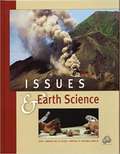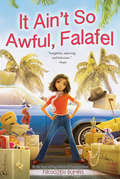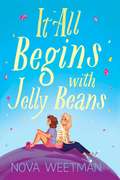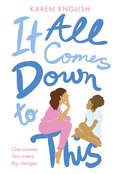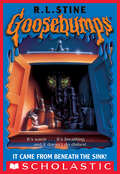- Table View
- List View
Issues and Life Science
by Barbara Nagle Manisha Hariani Donna MarkeyAs you examine the activities in this book, you may wonder, "Why does this book look so different from other science books I've seen?" The reason is simple: it is a different kind of science program, and only some of what you will learn can be seen by leafing through this book!
Issues and Life Science: From Cells to Organisms, Revised
by Lawrence Hall of Science University of California BerkeleyNIMAC-sourced textbook <p>How should we prevent the spread of an infectious disease? Students investigate how scientists first learned about cells and how this discovery led to new understandings of how infectious diseases spread. They gather evidence about the structures and functions of cells, develop models of cells, and explain how cells in animals and plants get the matter and energy they need to survive and grow. PE Assessment Example: Based on what you have learned in the “Cells Alive!” activity and this activity, draw a diagram (or create another type of model) to show what happens to the food you eat. Your model should show the movement of matter and the release of energy stored in food. From Cells to Organisms is part of Issues and Science three year middle school program, designed by SEPUP at the Lawrence Hall of Science. This five to six week unit anchors the lessons around the the socio-science issue: How should we prevent the spread of an infectious disease? Investigative phenomena within the 15 activities connect back to the issue and storyline. This unit builds towards and assesses PEs LS1-1, LS1-2, LS1-6, LS1-7.</p>
Issues and Life Science: Ecology, Revised
by Lawrence Hall of Science University of California BerkeleyNIMAC-sourced textbook <p>What kinds of future space missions should we fund and conduct? Students take observations from their everyday life and build scientific models to try to understand how phenomena, such as changes in the moon’s appearance, seasons, and gravity work. Through data collection and analyzation students later use their understanding of what can be learned through space missions to determine the trade-offs of different proposed space missions. PE Assessment Example: Prepare a labeled diagram that includes a caption explaining how Earth’s tilt and its orbit around the Sun cause each of the following: a. changes in the angle of sunlight hitting the Earth’s surface. b. the seasons in the Southern Hemisphere to be opposite of the seasons in the Northern Hemisphere. Solar System and Beyond is part of Issues and Science three year middle school program, designed by SEPUP at the Lawrence Hall of Science. This five week unit anchors the lessons around the the socio-science issue: What kind of future space missions should we fund and conduct? Investigative phenomena within the 17 activities connect back to the issue and storyline. This unit builds towards and assesses PEs ESS1-1, ESS1-2, ESS1-3. The Student Book guides students in exploring a socio-science issue and connected phemonena through a series of varied activity types. Activity types use one of twelve different instructional strategies to apply Science and Engineering Practices to specific Disciplinary Core Ideas and Cross Cutting Concepts. SEPUP's integrated literacy strategies help students process new science content, develop their analytical skills, make connections between related concepts, and express their knowledge orally and in writing. The built-in assessment system helps teachers identify students' strengths and weaknesses from the beginning of the unit. This allows them to adjust activities when needed so that all students get the best chance to build their knowledge and appreciation of science. At the back of the Student Book there is an Appendix containing additional resources for students, such as science skills, literacy strategies, and media literacy among others. </p>
Issues and Life Science: Body Systems, Revised
by Lawrence Hall of Science University of California BerkeleyNIMAC-sourced textbook
Issues and Life Science: Ecology
by University of California at Berkeley Lawrence Hall of ScienceNIMAC-sourced textbook
Issues and Life Science: Reproduction, Revised
by University of California at Berkeley Lawrence Hall of ScienceNIMAC-sourced textbook <p>How do people use chemical reactions to solve problems? Students analyze and interpret data to determine whether chemical reactions have taken place. They use models to explain what takes place at the atomic/molecular scale during a reaction. They also apply what they learn about chemical reactions to such problems as designing useful products and identifying processes for cleaning up chemical wastes. PE Assessment Example: Use the reaction you have just studied to design, test, and modify a device that can be used as a handwarmer. Chemical Reactions is part of Issues and Science three year middle school program, designed by SEPUP at the Lawrence Hall of Science. This three week unit anchors the lessons around the the socio-science issue: How do people use chemical reactions to solve problems? Investigative phenomena within the 13 activities connect back to the issue and storyline. This unit builds towards and assesses PEs PS1-2, PS1-5, PS1-6. The Student Book guides students in exploring a socio-science issue and connected phemonena through a series of varied activity types. Activity types use one of twelve different instructional strategies to apply Science and Engineering Practices to specific Disciplinary Core Ideas and Cross Cutting Concepts. SEPUP's integrated literacy strategies help students process new science content, develop their analytical skills, make connections between related concepts, and express their knowledge orally and in writing. The built-in assessment system helps teachers identify students' strengths and weaknesses from the beginning of the unit. This allows them to adjust activities when needed so that all students get the best chance to build their knowledge and appreciation of science. At the back of the Student Book there is an Appendix containing additional resources for students, such as science skills, literacy strategies, and media literacy among others.</p>
Issues and Life Science: Evolution, Revised
by University of California at Berkeley Lawrence Hall of ScienceNIMAC-sourced textbook <p>How are people affected by and affecting evolution? Students explore Charles Darwin’s theory of evolution by natural selection, how populations of organisms change over time and how new species arise while others go extinct. They also learn to interpret the many sources of evidence for the evolution of life on Earth now and in the past. PE Assessment Example: Explain how environmental changes affect the sickle cell trait over time in your population. Use evidence, including mathematical representations, from your investigation to support your explanation. Evolution is part of Issues and Science three year middle school program, designed by SEPUP at the Lawrence Hall of Science. This seven week unit anchors the lessons around the the socio-science issue: How are people affected by and affecting evolution? Investigative phenomena within the 17 activities connect back to the issue and storyline. This unit builds towards and assesses PEs LS3-1, LS4-1, LS4-2, LS4-3, LS4-4, LS4-5, LS4-6. The Student Book guides students in exploring a socio-science issue and connected phemonena through a series of varied activity types. Activity types use one of twelve different instructional strategies to apply Science and Engineering Practices to specific Disciplinary Core Ideas and Cross Cutting Concepts. SEPUP's integrated literacy strategies help students process new science content, develop their analytical skills, make connections between related concepts, and express their knowledge orally and in writing. The built-in assessment system helps teachers identify students' strengths and weaknesses from the beginning of the unit. This allows them to adjust activities when needed so that all students get the best chance to build their knowledge and appreciation of science. At the back of the Student Book there is an Appendix containing additional resources for students, such as science skills, literacy strategies, and media literacy among others.</p>
Issues and Life Science
by University of California at Berkeley Lawrence Hall of ScienceNIMAC-sourced textbook
Issues and Life Science, 2nd Edition
by SEPUP Lawrence Hall of Science University of California at BerkeleyScience textbook
Issues and Physical Science: Force and Motion
by University of California at Berkeley Lawrence Hall of ScienceNIMAC-sourced textbook
Issues and Physical Science: Force and Motion, Revised
by University of California at Berkeley Lawrence Hall of ScienceNIMAC-sourced textbook
Issues and Physical Science: Fields and Interactions, Revised
by University of California at Berkeley Lawrence Hall of ScienceNIMAC-sourced textbook <p>Fields and Interactions is part of Issues and Science three year middle school program, designed by SEPUP at the Lawrence Hall of Science. This five week unit anchors the lessons around the the socio-science issue: How do different types of force fields help us design transportation? This unit builds towards and assesses PEs PS2-3, PS2-4, PS2-5, PS3-2, ETS1-1, ETS1-2. The Student Book guides students in exploring a socio-science issue and connected phemonena through a series of varied activity types. Activity types use one of twelve different instructional strategies to apply Science and Engineering Practices to specific Disciplinary Core Ideas and Cross Cutting Concepts. SEPUP's integrated literacy strategies help students process new science content, develop their analytical skills, make connections between related concepts, and express their knowledge orally and in writing. The built-in assessment system helps teachers identify students' strengths and weaknesses from the beginning of the unit. This allows them to adjust activities when needed so that all students get the best chance to build their knowledge and appreciation of science. At the back of the Student Book there is an Appendix containing additional resources for students, such as science skills, literacy strategies, and media literacy among others.</p>
Issues and Physical Science: Energy, Revised
by University of California at Berkeley Lawrence Hall of ScienceNIMAC-sourced textbook <p>How can people manipulate energy transfer and transformation to use energy more efficiently? Students learn about the transfer and transformation of energy in their everyday lives. They plan and carry out investigations and analyze and interpret data from experiments to investigate how energy is transferred and transformed. They also engage in engineering challenges to design and test devices to maximize and minimize energy transfer. PE Assessment Example: Design, test, evaluate, and redesign a solar oven that maximizes thermal energy transfer. Energy is part of Issues and Science three year middle school program, designed by SEPUP at the Lawrence Hall of Science. This six week unit anchors the lessons around the the socio-science issue: How can people manipulate energy transfer and transformation to use energy more efficiently? Investigative phenomena within the 15 activities connect back to the issue and storyline. This unit builds towards and assesses PEs PS3-3, PS3-4, PS3-5, MS-ETS1-4. The Student Book guides students in exploring a socio-science issue and connected phemonena through a series of varied activity types. Activity types use one of twelve different instructional strategies to apply Science and Engineering Practices to specific Disciplinary Core Ideas and Cross Cutting Concepts. SEPUP's integrated literacy strategies help students process new science content, develop their analytical skills, make connections between related concepts, and express their knowledge orally and in writing. The built-in assessment system helps teachers identify students' strengths and weaknesses from the beginning of the unit. This allows them to adjust activities when needed so that all students get the best chance to build their knowledge and appreciation of science. At the back of the Student Book there is an Appendix containing additional resources for students, such as science skills, literacy strategies, and media literacy among others.</p>
Issues and Physical Science: Chemistry of Materials, Revised
by University of California at Berkeley Lawrence Hall of ScienceNIMAC-sourced textbook <p>How do people use chemical reactions to solve problems? Students analyze and interpret data to determine whether chemical reactions have taken place. They use models to explain what takes place at the atomic/molecular scale during a reaction. They also apply what they learn about chemical reactions to such problems as designing useful products and identifying processes for cleaning up chemical wastes. PE Assessment Example: Use the reaction you have just studied to design, test, and modify a device that can be used as a handwarmer. Chemical Reactions is part of Issues and Science three year middle school program, designed by SEPUP at the Lawrence Hall of Science. This three week unit anchors the lessons around the the socio-science issue: How do people use chemical reactions to solve problems? Investigative phenomena within the 13 activities connect back to the issue and storyline. This unit builds towards and assesses PEs PS1-2, PS1-5, PS1-6. The Student Book guides students in exploring a socio-science issue and connected phemonena through a series of varied activity types. Activity types use one of twelve different instructional strategies to apply Science and Engineering Practices to specific Disciplinary Core Ideas and Cross Cutting Concepts. SEPUP's integrated literacy strategies help students process new science content, develop their analytical skills, make connections between related concepts, and express their knowledge orally and in writing. The built-in assessment system helps teachers identify students' strengths and weaknesses from the beginning of the unit. This allows them to adjust activities when needed so that all students get the best chance to build their knowledge and appreciation of science. At the back of the Student Book there is an Appendix containing additional resources for students, such as science skills, literacy strategies, and media literacy among others.</p>
Issues and Physical Science: Chemical Reactions, Revised
by University of California at Berkeley Lawrence Hall of ScienceNIMAC-sourced textbook <p>How do people use chemical reactions to solve problems? Students analyze and interpret data to determine whether chemical reactions have taken place. They use models to explain what takes place at the atomic/molecular scale during a reaction. They also apply what they learn about chemical reactions to such problems as designing useful products and identifying processes for cleaning up chemical wastes. PE Assessment Example: Use the reaction you have just studied to design, test, and modify a device that can be used as a handwarmer. Chemical Reactions is part of Issues and Science three year middle school program, designed by SEPUP at the Lawrence Hall of Science. This three week unit anchors the lessons around the the socio-science issue: How do people use chemical reactions to solve problems? Investigative phenomena within the 13 activities connect back to the issue and storyline. This unit builds towards and assesses PEs PS1-2, PS1-5, PS1-6. The Student Book guides students in exploring a socio-science issue and connected phemonena through a series of varied activity types. Activity types use one of twelve different instructional strategies to apply Science and Engineering Practices to specific Disciplinary Core Ideas and Cross Cutting Concepts. SEPUP's integrated literacy strategies help students process new science content, develop their analytical skills, make connections between related concepts, and express their knowledge orally and in writing. The built-in assessment system helps teachers identify students' strengths and weaknesses from the beginning of the unit. This allows them to adjust activities when needed so that all students get the best chance to build their knowledge and appreciation of science. At the back of the Student Book there is an Appendix containing additional resources for students, such as science skills, literacy strategies, and media literacy among others.</p>
Issues and Physical Science: Energy
by University of California at Berkeley Lawrence Hall of ScienceNIMAC-sourced textbook
Issues and Physical Science: Waves, Revised
by University of California Berkeley Lawrence Hall of ScienceNIMAC-sourced textbook <p>How are waves both helpful and harmful? Students encounter a variety of technologies that make use of waves. They also investigate the harmful effects of certain waves and methods to mitigate the risks associated with these waves. PE Assessment Example: Use what you learned from your hands-on investigation to explain why noise is more of a problem for analog vs digital signals, and why digital signals are more reliable to encode and transmit information. Waves is part of Issues and Science three year middle school program, designed by SEPUP at the Lawrence Hall of Science. This five week unit anchors the lessons around the the socio-science issue: How are waves both helpful and harmful? Investigative phenomena within the 15 activities connect back to the issue and storyline. This unit builds towards and assesses PEs PS4-1, PS4-2, PS4-3. The Student Book guides students in exploring a socio-science issue and connected phemonena through a series of varied activity types. Activity types use one of twelve different instructional strategies to apply Science and Engineering Practices to specific Disciplinary Core Ideas and Cross Cutting Concepts. SEPUP's integrated literacy strategies help students process new science content, develop their analytical skills, make connections between related concepts, and express their knowledge orally and in writing. The built-in assessment system helps teachers identify students' strengths and weaknesses from the beginning of the unit. This allows them to adjust activities when needed so that all students get the best chance to build their knowledge and appreciation of science. At the back of the Student Book there is an Appendix containing additional resources for students, such as science skills, literacy strategies, and media literacy among others. </p>
Issues & Earth Science
by University of California at Berkeley Lawrence Hall of ScienceNIMAC-sourced textbook
Issues & Life Science
by University of California at Berkeley Lawrence Hall of ScienceNIMAC-sourced textbook
It Ain't So Awful, Falafel
by Firoozeh DumasZomorod (Cindy) Yousefzadeh is the new kid on the block . . . for the fourth time. California's Newport Beach is her family's latest perch, and she's determined to shuck her brainy loner persona and start afresh with a new Brady Bunch name--Cindy. <P><P>It's the late 1970s, and fitting in becomes more difficult as Iran makes U.S. headlines with protests, revolution, and finally the taking of American hostages. Even mood rings and puka shell necklaces can't distract Cindy from the anti-Iran sentiments that creep way too close to home. <P>A poignant yet lighthearted middle grade debut from the author of the best-selling Funny in Farsi.
It All Begins with Jelly Beans
by Nova WeetmanTwo girls form an unlikely friendship during their shared time in the school nurse’s office in this heartfelt middle grade novel for fans of Save Me a Seat and Insignificant Events in the Life of a Cactus. Meg spends her days hoping no one thinks too hard about why she wears the same t-shirt and slippers to school every day. Luckily, the nurse’s office provides a welcome escape from classmates who don’t understand…and snacks when food runs out at home. Riley knows fitting in at her new school would be a lot easier if her friends were more understanding of her type 1 diabetes. So she keeps her testing under wraps…and an emergency bag of jellybeans on hand. When Meg and Riley end up together in the nurse’s office one day, both girls think they’ve worked each other out, but what if they’ve got it all wrong? On the brink of moving on to junior high, Riley and Meg must find the courage to discover who they really want to be. And maybe a bag of shared jellybeans will provide all the help they need.
It All Comes Down to This
by Karen EnglishIt’s 1965, Los Angeles. <P><P> All twelve-year-old Sophie wants to do is write her book, star in the community play, and hang out with her friend Jennifer. <P><P>But she’s the new black kid in a nearly all-white neighborhood; her beloved sister, Lily, is going away to college soon; and her parents’ marriage is rocky. <P><P>There’s also her family’s new, disapproving housekeeper to deal with. <P><P>When riots erupt in nearby Watts and a friend is unfairly arrested, Sophie learns that life—and her own place in it—is even more complicated than she’d once thought. <P><P>Leavened with gentle humor, this story is perfect for fans of Rita Williams-Garcia.
It Came from Beneath the Sink!: Monster Blood Iii; It Came From Beneath The Sink; Night Of The Living Dummy 2; The Barking Ghost (Goosebumps #30)
by R.L. StineFrom the New York Times–bestselling Goosebumps series, two siblings discover a monster lurking beneath the sink of their new house that preys on bad luck. Kat and her brother, Daniel, are so lucky. They just moved to a new house with tons of rooms, two balconies, and a lawn the size of a football field. But all that good luck is about to run out. Because there’s something really evil living in their new house. Something that’s moving. Watching. Waiting. Something that comes from beneath the kitchen sink. It might look like an ordinary sponge. But this scary creature doesn’t do dishes. . . .
It Came From Ohio! My Life As A Writer
by R. L. StineA best-selling author tells kids everything they ever wanted to know about him--and Goosebumps! What was R. L. Stine like as a kid? How did he start writing books? Where does he get all his scary ideas? These and many more questions are answered in this humorous, fast-paced biography. Photos, line drawings.

